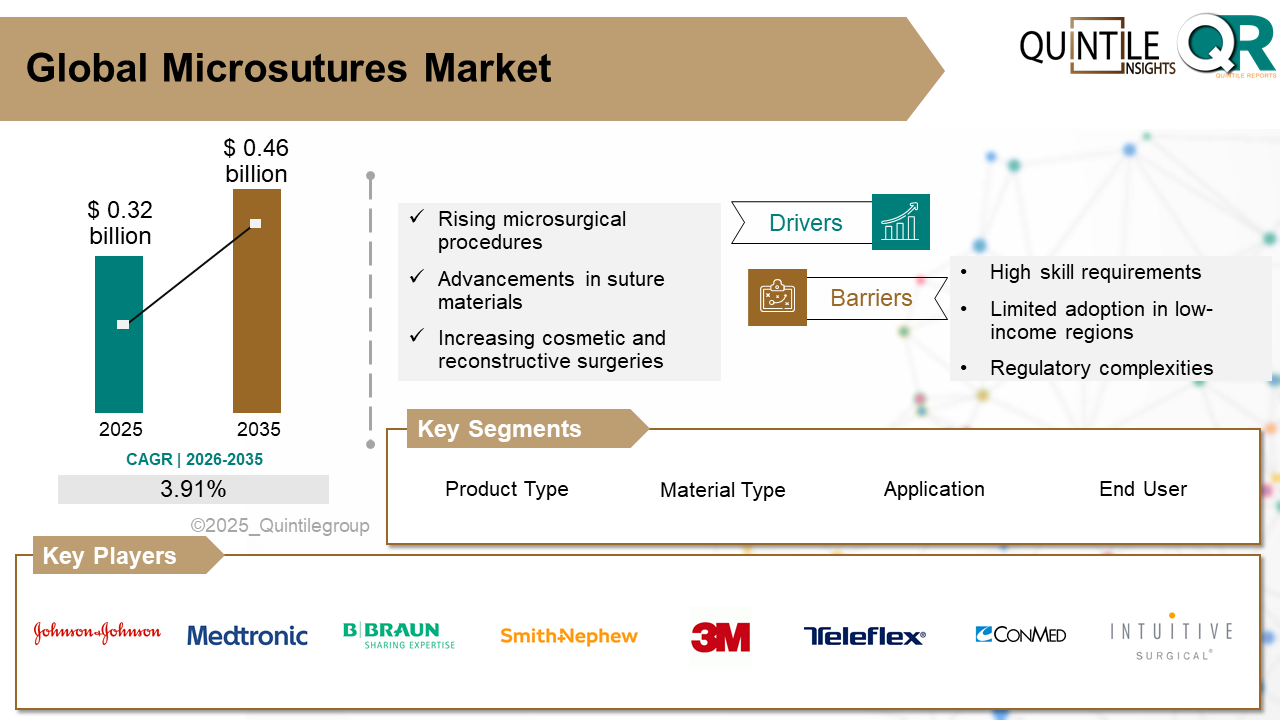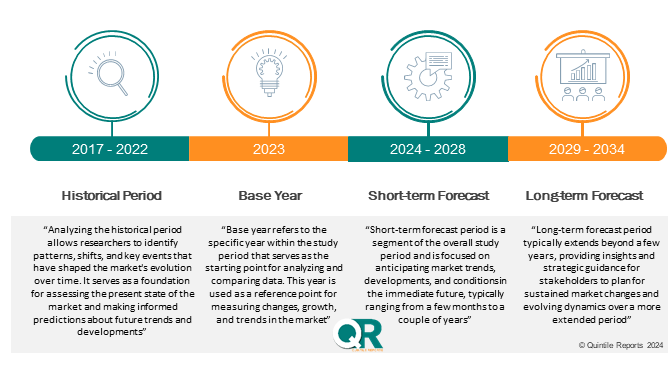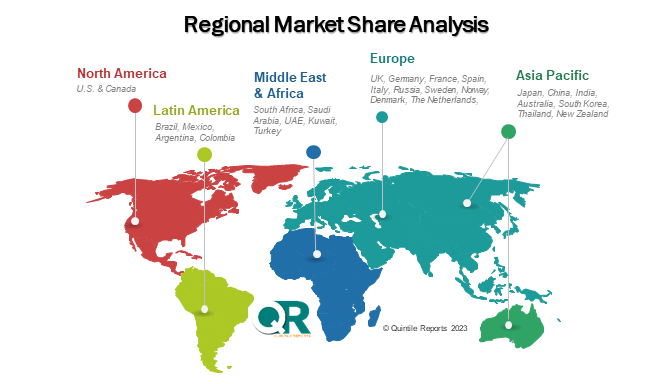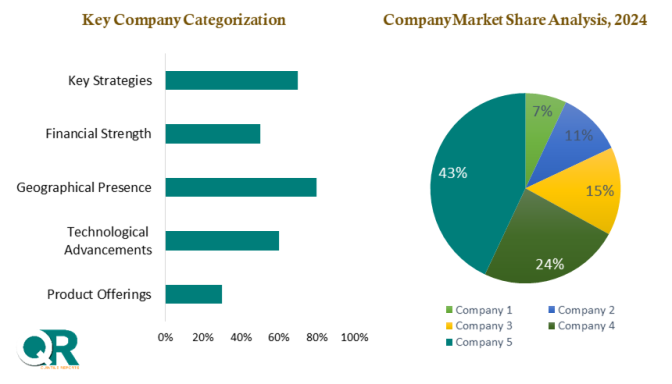The Global Microsutures Market was estimated at USD 0.32 billion in 2026 and is projected to reach USD 0.46 billion by 2035, reflecting a robust CAGR of 3.91% over the forecast period from 2026 to 2035. The Microsutures market report offers a comprehensive and nuanced view of the industry, moving beyond conventional analysis. It provides a thorough examination of the markets dynamics, encompassing a detailed exploration of the factors propelling growth, such as evolving economic conditions, advancements in technology, shifts in regulatory policies, and changes in consumer behavior. Furthermore, the report discusses the projected Compound Annual Growth Rate (CAGR), providing stakeholders with a clear understanding of the market's expected growth trajectory and offering data-driven insights into future market dynamics.
The Microsutures market under analysis is characterized by dynamic growth and evolving trends that are reshaping the competitive landscape. With 2025 serving as the base year for this Microsutures market study, recent data highlights a significant expansion driven by technological advancements, rising consumer demand, and a growing focus on innovation. Companies are refining their go-to-market (GTM) strategies to effectively capture these emerging opportunities and respond to the rapidly changing market dynamics.
Key trends influencing the Microsutures market include the rapid adoption of digital technologies, the integration of sustainable practices, and the increasing importance of customer experience. These trends are not only driving growth but also creating new challenges for industry participants, who must adapt their GTM strategies to navigate regulatory changes, supply chain disruptions, and fluctuating economic conditions. Despite these challenges, the Microsutures market is poised for sustained growth, with emerging markets playing a critical role in the expansion of the industry.
Looking ahead, the Microsutures market is forecasted to continue its upward momentum through 2035, supported by ongoing investments in research and development, strategic partnerships, and mergers and acquisitions. Companies that can effectively tailor their GTM strategies to the evolving market landscape, innovate, and meet shifting consumer demands are likely to achieve sustained success. Microsutures market report provides a comprehensive analysis of the current market environment and offers valuable insights into the key drivers, challenges, and opportunities that will shape the industry's future over the next decade. This report offers a comprehensive analysis of market dynamics across various segments, regions, and countries, incorporating both qualitative and quantitative data. It covers the period from 2017 to 2035, providing a detailed examination of historical performance, current market conditions, and future projections.
Historical Analysis (2017-2024): The report presents a thorough review of market trends, performance metrics, and growth trajectories for the years 2017 through 2024. This historical perspective is crucial for understanding past market behavior and identifying patterns that influence current and future market dynamics.
Forecast and Projections (2026-2035) : Building on historical data, the report provides forward-looking insights, including market forecasts and growth projections from 2026 to 2035. It details anticipated market trends, emerging opportunities, and potential challenges across different segments, regions, and countries.
Compound Annual Growth Rate (CAGR): The report includes a precise calculation of the compound annual growth rate (CAGR) for the forecast period of 2026 to 2035. This metric will be instrumental in assessing the expected growth trajectory and the overall market potential during the forecast period.

The microsutures market refers to the global and regional market for nylon non-absorbable, sterile surgical suture that is indicated for use in general soft tissue approximation and/or ligation, including use in microsurgical, cardiovascular, ophthalmic, and neurological procedures.
Microsutures are essential tools in microsurgical procedures that involve the repair or approximation of delicate structures like nerves, blood vessels, and ocular tissues under high magnification. These sutures are extremely fine typically ranging from USP6 0 to 11 0, with the finest (8 0 to 11 0) being used in the most intricate microsurgical techniques. Made from materials such as nylon monofilament, they are designed to minimize tissue trauma and support precise placement, often requiring specialized needles (e.g., taper-point) and instruments suited for microsurgical environments. Commonly employed in specialties like ophthalmology, neurosurgery, plastic and reconstructive surgery, and microvascular anastomosis, microsutures enable optimal healing in anatomically sensitive and high-stakes surgical contexts.
The microsutures market is highly competitive with key players focusing on innovation in suture materials, precision manufacturing, and expanding product portfolios. Leading companies invest heavily in R&D to develop sutures that improve surgical outcomes, reduce tissue trauma, and enhance ease of use under magnification.
Price competitiveness, regulatory approvals, and global distribution networks are critical factors influencing market share. Companies differentiate through proprietary coatings, biocompatible polymers, and integration with robotic-assisted surgery platforms. Strategic partnerships with healthcare providers and academic institutions also strengthen product adoption and clinical validation.
Emerging markets present significant growth opportunities, prompting manufacturers to tailor products for regional needs and cost constraints. Ongoing technological advances in automated suturing and absorbable microsutures are expected to further transform the competitive landscape.
Johnson & Johnson (Ethicon), Medtronic PLC, B. Braun Melsungen AG, Smith & Nephew plc, 3M Company, Teleflex Incorporated, Conmed Corporation, Intuitive Surgical, Inc., Zimmer Biomet Holdings, Inc., Boston Scientific Corporation, Stryker Corporation, Abbott Laboratories, Olympus Corporation, Hoya Corporation, KLS Martin Group.

Our team of experienced researchers has meticulously gathered and analyzed data to deliver a thorough examination of market dynamics, competitive landscape, and emerging technologies. With a focus on delivering actionable intelligence, this report aims to empower decision-makers with the information needed to make informed choices and stay ahead of the competition. Whether you are a seasoned industry player or a new entrant, our market research report serves as a strategic tool to navigate the complexities of the market, aiding in successful business planning and growth strategies.
This chapter of our Microsutures market report provides an in-depth examination of the factors shaping the industry landscape. This section typically encompasses several key elements to offer a comprehensive understanding of the industry landscape such as market drivers & restraints analysis, market opportunities & trend analysis, market size & growth analysis, competitive analysis, SWOT analysis, business environment tools such as Porter's five forces & PESTEL analysis, Ansoff Matrix analysis, penetration & growth prospect analysis, regulatory framework & reimbursement scenario analysis, impact of macro & micro economic factors analysis such as Covid-19 impact, GDP growth, market inflation, U.S.- China trade war, Russia-Ukraine war impact, and supply chain analysis.
The segment analysis chapter of Microsutures market report is a critical section that delves into a detailed examination of the market's various segments. Segmentation involves dividing the market into distinct categories based on certain criteria to better understand and address the diverse needs of consumers. This chapter typically follows the introduction and provides a more granular view of the market, offering valuable insights for businesses and stakeholders. The components of the chapter lude segment definitions to understand the inclusions and exclusions of the study, assumptions, market size estimates and growth trend analysis of each segment, qualitative analysis of the segment, technological advancements, market penetration rate, market adoption rate, market share examination by each segment, segment growth drivers and restraint barriers, consumer behaviour and challenge analysis.
The chapter in Microsutures market research report is a pivotal section that examines and predicts the market dynamics and trends specific to different geographical regions. This chapter is crucial for businesses and stakeholders seeking a comprehensive understanding of how the market behaves across various locations, enabling them to tailor strategies and make informed decisions based on regional variations. The regional analysis chapter of our Microsutures market report is classified into regions & country-level. The chapter consists of North America (U.S., Canada), Europe (UK, Germany, France, Italy, Spain, Russia, Sweden, Denmark, Norway, Rest of Europe), Asia Pacific (Japan, China, India, Australia, South Korea, Thailand, Rest of Asia Pacific), Latin America (Brazil, Mexico, Argentina, Colombia, Rest of Latin America), Middle East & Africa (South Africa, Saudi Arabia, UAE, Kuwait, Rest of Middle East & Africa).

This section of a Microsutures market report is a crucial segment that provides a comprehensive overview of the competitive landscape within the market. This section is vital for businesses, investors, and stakeholders seeking insights into key players, their market positioning, strengths, weaknesses, strategies, and potential impacts on the overall market dynamics. The chapter includes research methodology used to analyse the market competition, list of key players operating in the market, detailed company profile section which includes company overview, business verticals, financial performance, product/services benchmarking, geographical presence, and strategic initiatives.

| Report Scope | Details |
| Report Version | 2026 |
| Growth Rate | CAGR of 3.91 from 2026 to 2035 |
| Base year | 2025 |
| Actual estimates/Historical data | 2017 - 2024 |
| Forecast period | 2026 - 2035 |
| Quantitative units | Revenue in USD million/billion & CAGR from 2026 to 2035 |
| Country scope | North America (U.S., Canada), Europe (UK, Germany, France, Italy, Spain, Russia, Sweden, Denmark, Norway, Rest of Europe), Asia Pacific (Japan, China, India, Australia, South Korea, Thailand, Rest of Asia Pacific), Latin America (Brazil, Mexico, Argentina, Colombia, Rest of Latin America), Middle East & Africa (South Africa, Saudi Arabia, UAE, Kuwait, Rest of Middle East & Africa). |
| The Segment covered by Product |
|
| The Segment covered by Type |
|
| Companies covered |
|
| Report coverage | Revenue forecast, company share, competitive landscape, growth factors, and trends |
| Free customization scope (equivalent to 5 analyst working days) | If you need specific information, which is not currently within the scope of the report, we will provide it to you as a part of the customization |

Statistics for the 2025 Microsutures market share, size, and revenue growth rate were created by Quintile Report™. Microsutures analysis includes a market forecast outlook for 2035 and a historical overview. Get a free PDF sample of this market analysis, please get in touch with our principal analyst at sales@quintilereports.com
List of Tables
Table 1 List of Abbreviation and acronyms
Table 2 List of Sources
Table 3 North America Global Microsutures Market, by Segment Analysis, (USD Million) 2017-2035
Table 4 North America Global Microsutures Market, by Region, (USD Million) 2017-2035
Table 5 U.S. Global Microsutures Market, by Segment Analysis, (USD Million) 2017-2035
Table 6 Canada Global Microsutures Market, by Segment Analysis, (USD Million) 2017-2035
Table 7 Europe Global Microsutures Market, by Segment Analysis, (USD Million) 2017-2035
Table 8 Europe Global Microsutures Market, by Region, (USD Million) 2017-2035
Table 9 Germany Global Microsutures Market, by Segment Analysis, (USD Million) 2017-2035
Table 10 U.K. Global Microsutures Market, by Segment Analysis, (USD Million) 2017-2035
Table 11 France Global Microsutures Market, by Segment Analysis, (USD Million) 2017-2035
Table 12 Italy Global Microsutures Market, by Segment Analysis, (USD Million) 2017-2035
Table 13 Spain Global Microsutures Market, by Segment Analysis, (USD Million) 2017-2035
Table 14 Sweden Global Microsutures Market, by Segment Analysis, (USD Million) 2017-2035
Table 15 Denmark Global Microsutures Market, by Segment Analysis, (USD Million) 2017-2035
Table 16 Norway Global Microsutures Market, by Segment Analysis, (USD Million) 2017-2035
Table 17 The Netherlands Global Microsutures Market, by Segment Analysis, (USD Million) 2017-2035
Table 18 Russia Global Microsutures Market, by Segment Analysis, (USD Million) 2017-2035
Table 19 Asia Pacific Global Microsutures Market, by Segment Analysis, (USD Million) 2017-2035
Table 20 Asia Pacific Global Microsutures Market, by Region, (USD Million) 2017-2035
Table 21 China Global Microsutures Market, by Segment Analysis, (USD Million) 2017-2035
Table 22 Japan Global Microsutures Market, by Segment Analysis, (USD Million) 2017-2035
Table 23 India Global Microsutures Market, by Segment Analysis, (USD Million) 2017-2035
Table 24 Australia Global Microsutures Market, by Segment Analysis, (USD Million) 2017-2035
Table 25 South Korea Global Microsutures Market, by Segment Analysis, (USD Million) 2017-2035
Table 26 Thailand Global Microsutures Market, by Segment Analysis, (USD Million) 2017-2035
Table 27 Latin America Global Microsutures Market, by Segment Analysis, (USD Million) 2017-2035
Table 28 Latin America Global Microsutures Market, by Region, (USD Million) 2017-2035
Table 29 Brazil Global Microsutures Market, by Segment Analysis, (USD Million) 2017-2035
Table 30 Mexico Global Microsutures Market, by Segment Analysis, (USD Million) 2017-2035
Table 31 Argentina Global Microsutures Market, by Segment Analysis, (USD Million) 2017-2035
Table 32 Middle East and Africa Global Microsutures Market, by Segment Analysis, (USD Million) 2017-2035
Table 33 Middle East and Africa Global Microsutures Market, by Region, (USD Million) 2017-2035
Table 34 South Africa Global Microsutures Market, by Segment Analysis, (USD Million) 2017-2035
Table 35 Saudi Arabia Global Microsutures Market, by Segment Analysis, (USD Million) 2017-2035
Table 36 UAE Global Microsutures Market, by Segment Analysis, (USD Million) 2017-2035
Table 37 Kuwait Global Microsutures Market, by Segment Analysis, (USD Million) 2017-2035
Table 38 Turkey Global Microsutures Market, by Segment Analysis, (USD Million) 2017-2035
Fig.1 Market research process
Fig.2 Market research approaches
Fig.3 Global Microsutures Market: market scenario
Fig.4 Global Microsutures Market competitive outlook
Fig.5 Global Microsutures Market driver analysis
Fig.6 Global Microsutures Market restraint analysis
Fig.7 Global Microsutures Market opportunity analysis
Fig.8 Global Microsutures Market trends analysis
Fig.9 Global Microsutures Market: Segment Analysis (Based on the scope)
Fig.10 Global Microsutures Market: regional analysis
Fig.11 Global market shares and leading market players
Fig.12 North America market share and leading players
Fig.13 Europe market share and leading players
Fig.14 Asia Pacific market share and leading players
Fig.15 Latin America market share and leading players
Fig.16 Middle East & Africa market share and leading players
Fig.17 North America, by country
Fig.18 North America
Fig.19 North America market estimates and forecast, 2017-2035
Fig.20 U.S.
Fig.21 Canada
Fig.22 Europe
Fig.23 Europe market estimates and forecast, 2017-2035
Fig.24 U.K.
Fig.25 Germany
Fig.26 France
Fig.27 Italy
Fig.28 Spain
Fig.29 Sweden
Fig.30 Denmark
Fig.31 Norway
Fig.32 The Netherlands
Fig.33 Russia
Fig.34 Asia Pacific
Fig.35 Asia Pacific market estimates and forecast, 2017-2035
Fig.36 China
Fig.37 Japan
Fig.38 India
Fig.39 Australia
Fig.40 South Korea
Fig.41 Thailand
Fig.42 Latin America
Fig.43 Latin America market estimates and forecast, 2017-2035
Fig.44 Brazil
Fig.45 Mexico
Fig.46 Argentina
Fig.47 Colombia
Fig.48 Middle East and Africa
Fig.49 Middle East and Africa market estimates and forecast, 2017-2035
Fig.50 Saudi Arabia
Fig.51 South Africa
Fig.52 UAE
Fig.53 Kuwait
Fig.54 Turkey
The Global Microsutures Market was estimated at USD 0.32 billion in 2026 and is projected to reach USD 0.46 billion by 2035, reflecting a robust CAGR of 3.91% over the forecast period from 2026 to 2035. The Microsutures market report offers a comprehensive and nuanced view of the industry, moving beyond conventional analysis. It provides a thorough examination of the markets dynamics, encompassing a detailed exploration of the factors propelling growth, such as evolving economic conditions, advancements in technology, shifts in regulatory policies, and changes in consumer behavior. Furthermore, the report discusses the projected Compound Annual Growth Rate (CAGR), providing stakeholders with a clear understanding of the market's expected growth trajectory and offering data-driven insights into future market dynamics.
The Microsutures market under analysis is characterized by dynamic growth and evolving trends that are reshaping the competitive landscape. With 2025 serving as the base year for this Microsutures market study, recent data highlights a significant expansion driven by technological advancements, rising consumer demand, and a growing focus on innovation. Companies are refining their go-to-market (GTM) strategies to effectively capture these emerging opportunities and respond to the rapidly changing market dynamics.
Key trends influencing the Microsutures market include the rapid adoption of digital technologies, the integration of sustainable practices, and the increasing importance of customer experience. These trends are not only driving growth but also creating new challenges for industry participants, who must adapt their GTM strategies to navigate regulatory changes, supply chain disruptions, and fluctuating economic conditions. Despite these challenges, the Microsutures market is poised for sustained growth, with emerging markets playing a critical role in the expansion of the industry.
Looking ahead, the Microsutures market is forecasted to continue its upward momentum through 2035, supported by ongoing investments in research and development, strategic partnerships, and mergers and acquisitions. Companies that can effectively tailor their GTM strategies to the evolving market landscape, innovate, and meet shifting consumer demands are likely to achieve sustained success. Microsutures market report provides a comprehensive analysis of the current market environment and offers valuable insights into the key drivers, challenges, and opportunities that will shape the industry's future over the next decade. This report offers a comprehensive analysis of market dynamics across various segments, regions, and countries, incorporating both qualitative and quantitative data. It covers the period from 2017 to 2035, providing a detailed examination of historical performance, current market conditions, and future projections.
Historical Analysis (2017-2024): The report presents a thorough review of market trends, performance metrics, and growth trajectories for the years 2017 through 2024. This historical perspective is crucial for understanding past market behavior and identifying patterns that influence current and future market dynamics.
Forecast and Projections (2026-2035) : Building on historical data, the report provides forward-looking insights, including market forecasts and growth projections from 2026 to 2035. It details anticipated market trends, emerging opportunities, and potential challenges across different segments, regions, and countries.
Compound Annual Growth Rate (CAGR): The report includes a precise calculation of the compound annual growth rate (CAGR) for the forecast period of 2026 to 2035. This metric will be instrumental in assessing the expected growth trajectory and the overall market potential during the forecast period.

The microsutures market refers to the global and regional market for nylon non-absorbable, sterile surgical suture that is indicated for use in general soft tissue approximation and/or ligation, including use in microsurgical, cardiovascular, ophthalmic, and neurological procedures.
Microsutures are essential tools in microsurgical procedures that involve the repair or approximation of delicate structures like nerves, blood vessels, and ocular tissues under high magnification. These sutures are extremely fine typically ranging from USP6 0 to 11 0, with the finest (8 0 to 11 0) being used in the most intricate microsurgical techniques. Made from materials such as nylon monofilament, they are designed to minimize tissue trauma and support precise placement, often requiring specialized needles (e.g., taper-point) and instruments suited for microsurgical environments. Commonly employed in specialties like ophthalmology, neurosurgery, plastic and reconstructive surgery, and microvascular anastomosis, microsutures enable optimal healing in anatomically sensitive and high-stakes surgical contexts.
The microsutures market is highly competitive with key players focusing on innovation in suture materials, precision manufacturing, and expanding product portfolios. Leading companies invest heavily in R&D to develop sutures that improve surgical outcomes, reduce tissue trauma, and enhance ease of use under magnification.
Price competitiveness, regulatory approvals, and global distribution networks are critical factors influencing market share. Companies differentiate through proprietary coatings, biocompatible polymers, and integration with robotic-assisted surgery platforms. Strategic partnerships with healthcare providers and academic institutions also strengthen product adoption and clinical validation.
Emerging markets present significant growth opportunities, prompting manufacturers to tailor products for regional needs and cost constraints. Ongoing technological advances in automated suturing and absorbable microsutures are expected to further transform the competitive landscape.
Johnson & Johnson (Ethicon), Medtronic PLC, B. Braun Melsungen AG, Smith & Nephew plc, 3M Company, Teleflex Incorporated, Conmed Corporation, Intuitive Surgical, Inc., Zimmer Biomet Holdings, Inc., Boston Scientific Corporation, Stryker Corporation, Abbott Laboratories, Olympus Corporation, Hoya Corporation, KLS Martin Group.

Our team of experienced researchers has meticulously gathered and analyzed data to deliver a thorough examination of market dynamics, competitive landscape, and emerging technologies. With a focus on delivering actionable intelligence, this report aims to empower decision-makers with the information needed to make informed choices and stay ahead of the competition. Whether you are a seasoned industry player or a new entrant, our market research report serves as a strategic tool to navigate the complexities of the market, aiding in successful business planning and growth strategies.
This chapter of our Microsutures market report provides an in-depth examination of the factors shaping the industry landscape. This section typically encompasses several key elements to offer a comprehensive understanding of the industry landscape such as market drivers & restraints analysis, market opportunities & trend analysis, market size & growth analysis, competitive analysis, SWOT analysis, business environment tools such as Porter's five forces & PESTEL analysis, Ansoff Matrix analysis, penetration & growth prospect analysis, regulatory framework & reimbursement scenario analysis, impact of macro & micro economic factors analysis such as Covid-19 impact, GDP growth, market inflation, U.S.- China trade war, Russia-Ukraine war impact, and supply chain analysis.
The segment analysis chapter of Microsutures market report is a critical section that delves into a detailed examination of the market's various segments. Segmentation involves dividing the market into distinct categories based on certain criteria to better understand and address the diverse needs of consumers. This chapter typically follows the introduction and provides a more granular view of the market, offering valuable insights for businesses and stakeholders. The components of the chapter lude segment definitions to understand the inclusions and exclusions of the study, assumptions, market size estimates and growth trend analysis of each segment, qualitative analysis of the segment, technological advancements, market penetration rate, market adoption rate, market share examination by each segment, segment growth drivers and restraint barriers, consumer behaviour and challenge analysis.
The chapter in Microsutures market research report is a pivotal section that examines and predicts the market dynamics and trends specific to different geographical regions. This chapter is crucial for businesses and stakeholders seeking a comprehensive understanding of how the market behaves across various locations, enabling them to tailor strategies and make informed decisions based on regional variations. The regional analysis chapter of our Microsutures market report is classified into regions & country-level. The chapter consists of North America (U.S., Canada), Europe (UK, Germany, France, Italy, Spain, Russia, Sweden, Denmark, Norway, Rest of Europe), Asia Pacific (Japan, China, India, Australia, South Korea, Thailand, Rest of Asia Pacific), Latin America (Brazil, Mexico, Argentina, Colombia, Rest of Latin America), Middle East & Africa (South Africa, Saudi Arabia, UAE, Kuwait, Rest of Middle East & Africa).

This section of a Microsutures market report is a crucial segment that provides a comprehensive overview of the competitive landscape within the market. This section is vital for businesses, investors, and stakeholders seeking insights into key players, their market positioning, strengths, weaknesses, strategies, and potential impacts on the overall market dynamics. The chapter includes research methodology used to analyse the market competition, list of key players operating in the market, detailed company profile section which includes company overview, business verticals, financial performance, product/services benchmarking, geographical presence, and strategic initiatives.

| Report Scope | Details |
| Report Version | 2026 |
| Growth Rate | CAGR of 3.91 from 2026 to 2035 |
| Base year | 2025 |
| Actual estimates/Historical data | 2017 - 2024 |
| Forecast period | 2026 - 2035 |
| Quantitative units | Revenue in USD million/billion & CAGR from 2026 to 2035 |
| Country scope | North America (U.S., Canada), Europe (UK, Germany, France, Italy, Spain, Russia, Sweden, Denmark, Norway, Rest of Europe), Asia Pacific (Japan, China, India, Australia, South Korea, Thailand, Rest of Asia Pacific), Latin America (Brazil, Mexico, Argentina, Colombia, Rest of Latin America), Middle East & Africa (South Africa, Saudi Arabia, UAE, Kuwait, Rest of Middle East & Africa). |
| The Segment covered by Product |
|
| The Segment covered by Type |
|
| Companies covered |
|
| Report coverage | Revenue forecast, company share, competitive landscape, growth factors, and trends |
| Free customization scope (equivalent to 5 analyst working days) | If you need specific information, which is not currently within the scope of the report, we will provide it to you as a part of the customization |

Statistics for the 2025 Microsutures market share, size, and revenue growth rate were created by Quintile Report™. Microsutures analysis includes a market forecast outlook for 2035 and a historical overview. Get a free PDF sample of this market analysis, please get in touch with our principal analyst at sales@quintilereports.com
Table 1 List of Abbreviation and acronyms
Table 2 List of Sources
Table 3 North America Global Microsutures Market, by Segment Analysis, (USD Million) 2017-2035
Table 4 North America Global Microsutures Market, by Region, (USD Million) 2017-2035
Table 5 U.S. Global Microsutures Market, by Segment Analysis, (USD Million) 2017-2035
Table 6 Canada Global Microsutures Market, by Segment Analysis, (USD Million) 2017-2035
Table 7 Europe Global Microsutures Market, by Segment Analysis, (USD Million) 2017-2035
Table 8 Europe Global Microsutures Market, by Region, (USD Million) 2017-2035
Table 9 Germany Global Microsutures Market, by Segment Analysis, (USD Million) 2017-2035
Table 10 U.K. Global Microsutures Market, by Segment Analysis, (USD Million) 2017-2035
Table 11 France Global Microsutures Market, by Segment Analysis, (USD Million) 2017-2035
Table 12 Italy Global Microsutures Market, by Segment Analysis, (USD Million) 2017-2035
Table 13 Spain Global Microsutures Market, by Segment Analysis, (USD Million) 2017-2035
Table 14 Sweden Global Microsutures Market, by Segment Analysis, (USD Million) 2017-2035
Table 15 Denmark Global Microsutures Market, by Segment Analysis, (USD Million) 2017-2035
Table 16 Norway Global Microsutures Market, by Segment Analysis, (USD Million) 2017-2035
Table 17 The Netherlands Global Microsutures Market, by Segment Analysis, (USD Million) 2017-2035
Table 18 Russia Global Microsutures Market, by Segment Analysis, (USD Million) 2017-2035
Table 19 Asia Pacific Global Microsutures Market, by Segment Analysis, (USD Million) 2017-2035
Table 20 Asia Pacific Global Microsutures Market, by Region, (USD Million) 2017-2035
Table 21 China Global Microsutures Market, by Segment Analysis, (USD Million) 2017-2035
Table 22 Japan Global Microsutures Market, by Segment Analysis, (USD Million) 2017-2035
Table 23 India Global Microsutures Market, by Segment Analysis, (USD Million) 2017-2035
Table 24 Australia Global Microsutures Market, by Segment Analysis, (USD Million) 2017-2035
Table 25 South Korea Global Microsutures Market, by Segment Analysis, (USD Million) 2017-2035
Table 26 Thailand Global Microsutures Market, by Segment Analysis, (USD Million) 2017-2035
Table 27 Latin America Global Microsutures Market, by Segment Analysis, (USD Million) 2017-2035
Table 28 Latin America Global Microsutures Market, by Region, (USD Million) 2017-2035
Table 29 Brazil Global Microsutures Market, by Segment Analysis, (USD Million) 2017-2035
Table 30 Mexico Global Microsutures Market, by Segment Analysis, (USD Million) 2017-2035
Table 31 Argentina Global Microsutures Market, by Segment Analysis, (USD Million) 2017-2035
Table 32 Middle East and Africa Global Microsutures Market, by Segment Analysis, (USD Million) 2017-2035
Table 33 Middle East and Africa Global Microsutures Market, by Region, (USD Million) 2017-2035
Table 34 South Africa Global Microsutures Market, by Segment Analysis, (USD Million) 2017-2035
Table 35 Saudi Arabia Global Microsutures Market, by Segment Analysis, (USD Million) 2017-2035
Table 36 UAE Global Microsutures Market, by Segment Analysis, (USD Million) 2017-2035
Table 37 Kuwait Global Microsutures Market, by Segment Analysis, (USD Million) 2017-2035
Table 38 Turkey Global Microsutures Market, by Segment Analysis, (USD Million) 2017-2035
Fig.1 Market research process
Fig.2 Market research approaches
Fig.3 Global Microsutures Market: market scenario
Fig.4 Global Microsutures Market competitive outlook
Fig.5 Global Microsutures Market driver analysis
Fig.6 Global Microsutures Market restraint analysis
Fig.7 Global Microsutures Market opportunity analysis
Fig.8 Global Microsutures Market trends analysis
Fig.9 Global Microsutures Market: Segment Analysis (Based on the scope)
Fig.10 Global Microsutures Market: regional analysis
Fig.11 Global market shares and leading market players
Fig.12 North America market share and leading players
Fig.13 Europe market share and leading players
Fig.14 Asia Pacific market share and leading players
Fig.15 Latin America market share and leading players
Fig.16 Middle East & Africa market share and leading players
Fig.17 North America, by country
Fig.18 North America
Fig.19 North America market estimates and forecast, 2017-2035
Fig.20 U.S.
Fig.21 Canada
Fig.22 Europe
Fig.23 Europe market estimates and forecast, 2017-2035
Fig.24 U.K.
Fig.25 Germany
Fig.26 France
Fig.27 Italy
Fig.28 Spain
Fig.29 Sweden
Fig.30 Denmark
Fig.31 Norway
Fig.32 The Netherlands
Fig.33 Russia
Fig.34 Asia Pacific
Fig.35 Asia Pacific market estimates and forecast, 2017-2035
Fig.36 China
Fig.37 Japan
Fig.38 India
Fig.39 Australia
Fig.40 South Korea
Fig.41 Thailand
Fig.42 Latin America
Fig.43 Latin America market estimates and forecast, 2017-2035
Fig.44 Brazil
Fig.45 Mexico
Fig.46 Argentina
Fig.47 Colombia
Fig.48 Middle East and Africa
Fig.49 Middle East and Africa market estimates and forecast, 2017-2035
Fig.50 Saudi Arabia
Fig.51 South Africa
Fig.52 UAE
Fig.53 Kuwait
Fig.54 Turkey

A license granted to one user. Rules or conditions might be applied for e.g. the use of electric files (PDFs) or printings, depending on product.
A license granted to multiple users.
A license granted to a single business site/establishment.
A license granted to all employees within organisation access to the product.
Immediate / Within 24-48 hours - Working days
Online Payments with PayPal and CCavenue
You can order a report by picking any of the payment methods which is bank wire or online payment through any Debit/Credit card or PayPal.
Hard Copy
Report Descriptions: The Global Cyanoacrylate Surgical Sealants And Adhesives Market was estimated a
Read MoreReport Descriptions: The Global AI In Ophthalmology Market was estimated at USD 283.78 million in 20
Read More